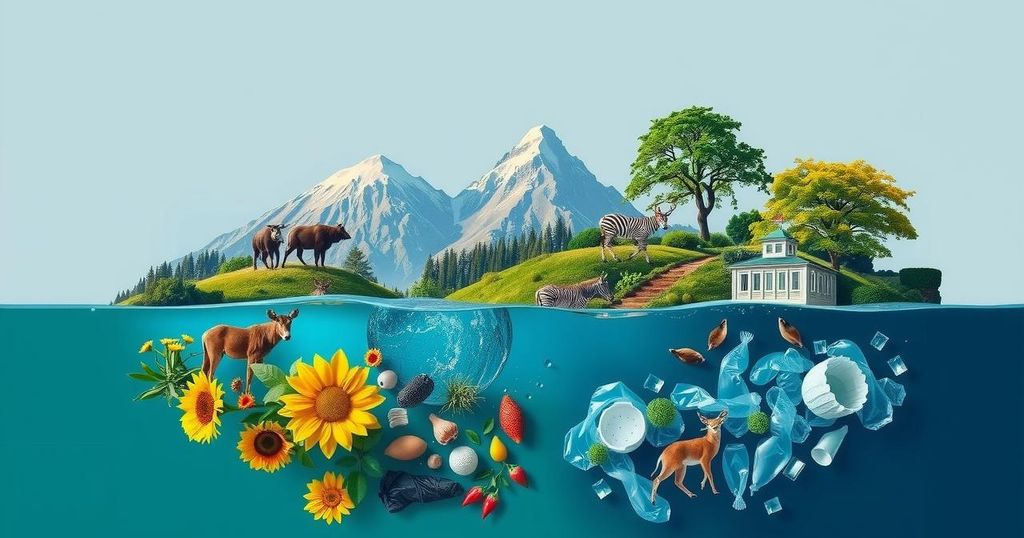As nearly 200 nations prepare to meet in 2024 to address biodiversity loss, climate change, and plastic pollution, experts stress the interconnectivity of these crises. Upcoming summits in Colombia, Azerbaijan, and South Korea aim to tackle these pressing issues, with significant implications for global environmental health.
As the year 2024 approaches its conclusion, an unprecedented assembly of nearly 200 countries will convene at three pivotal conferences aimed at addressing pressing global concerns: the decline of biodiversity, the escalating challenges presented by climate change, and the alarming rise of plastic pollution. In the coming weeks, Colombia will initiate discussions to evaluate worldwide efforts to safeguard 30% of terrestrial and aquatic ecosystems by the year 2030. Shortly thereafter, Azerbaijan will host COP29, where nations will reaffirm their commitment to shift away from the fossil fuels that exacerbate climate crises. Finally, in December, South Korea may witness the establishment of the first international agreement to combat plastic waste. Experts emphasize that while these events may appear distinct, they are intrinsically linked. “Climate change, biodiversity loss and resource depletion are not isolated problems,” assert biologist Liette Vasseur of Brock University, political scientist Anders Hayden of Dalhousie University, and ecologist Mike Jones of the Swedish University of Agricultural Sciences. “They are part of an interconnected web of crises that demand urgent and comprehensive action.” The current climate situation is dire, as scientists Seth Wynes and H. Damon Matthews from the University of Waterloo and Concordia University highlight the crucial question of projected temperature rises due to greenhouse gas emissions. Their findings suggest that if trends continue, a potential rise of 2.7°C by 2100 is plausible, based on a survey of specialists in climate science. They warn that at 1.3°C above pre-industrial levels, the world is already facing severe repercussions, including intensified flooding, heatwaves, and wildfires. In tandem with climate disruptions, the health of ecosystems is deteriorating. A recent report by the World Wildlife Fund indicates that since 1970, the average size of monitored vertebrate populations has plummeted by 73%. This decline jeopardizes crucial biodiversity services that support ecosystems rich in carbon storage, thus compounding climate issues. Plastic pollution adds another layer of complexity to these interlinked crises. Microplastics, which originate from larger plastic items that degrade, are now prevalent even in the most remote ecosystems, affecting organisms at all levels of the food chain. Karen Raubenheimer, an expert in this field, states, “In short, microplastics are widespread, accumulating in the remotest parts of our planet. There is evidence of their toxic effects at every level of biological organization.” Moreover, the connection between plastic production, a process heavily reliant on fossil fuels, and climate change is underscored by the urgent call from experts like Costas Velis for production limits in order to alleviate future impacts. Despite ongoing efforts, significant challenges remain. Reports indicate that the transition away from fossil fuels is occurring more slowly than necessary to meet climate objectives, and progress towards protecting a substantial portion of Earth’s ecosystems is just in its infancy. Some scholars challenge the effectiveness of merely establishing protected areas for biodiversity conservation, arguing that without confronting the underlying economic drivers of habitat degradation, these measures may be inadequate. The complexity of these interrelated environmental issues underscores the necessity for a holistic approach to conservation and climate action. Failure to address these collectively may hinder the aspirations set forth in upcoming global summits, ultimately exacerbating the ongoing rift between humanity and the natural world.
In 2024, the international community faces a pivotal moment marked by a series of summits that address three critical environmental issues affecting the planet: biodiversity loss, climate change, and plastic pollution. As the effects of these crises become increasingly apparent, the urgency for comprehensive action grows more pronounced. These summits, while individually focused, operate within a framework of interconnected challenges that exacerbate one another. Effective solutions necessitate collaborative strategies that acknowledge both the symbiotic and adversarial relationships between these environmental issues.
In summary, the upcoming international summits aim to tackle significant environmental challenges—biodiversity loss, climate change, and plastic pollution—that are interrelated and require unified action. Current scientific findings reveal alarming trends that threaten ecosystems and highlight the urgent need for policy changes to mitigate these crises. As experts point out, without addressing the root causes of these problems and fostering global cooperation, efforts to protect the environment will likely remain inadequate and may fail to reverse the damaging trends observed today.
Original Source: phys.org






